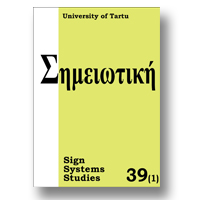|
approaches to communication |
|
61.
|
Sign Systems Studies:
Volume >
39 >
Issue: 1
Ülle Pärl
Коммуникация в процессе руководства и мониторинга (MACS):
семиотическая альтернатива. Резюме
view |
rights & permissions
| cited by
|
|
|
|
|
62.
|
Sign Systems Studies:
Volume >
39 >
Issue: 1
Ülle Pärl
Kommunikatsioon juhtimisarvestuse ja monitooringu protsessis:
semiootikal põhinev alternatiiv. Kokkuvõte
view |
rights & permissions
| cited by
|
|
|
|
|
63.
|
Sign Systems Studies:
Volume >
39 >
Issue: 1
Torkild Thellefsen, Bent Sørensen, Martin Thellefsen
The significance-effect is a communicational effect:
Introducing the DynaCom
abstract |
view |
rights & permissions
| cited by
The paper presents the concept significance-effect outlined in a Peircean inspired communication model, named DynaCom. The significance effect is a communicational effect; the formal conditions for the release of the significance-effect are the following: (1) Communication has to take place within a universeof discourse; (2) Utterer and interpreter must share collateral experience; and (3) The cominterpretant must occur. If these conditions are met the meaning of thecommunicated sign is likely to be correctly interpreted by the interpreter. Here, correctly means in accordance with the intentions of the utterer. The scope of thesignificance-effect has changed from knowledge effects caused by technical terms to emotional effects caused by lifestyle values in brands, for example.
|
|
|
|
|
64.
|
Sign Systems Studies:
Volume >
39 >
Issue: 1
Torkild Thellefsen, Bent Sørensen, Martin Thellefsen
Сигнификационный или коммуникативный эффект:
ознакомление с DynaCom. Резюме
view |
rights & permissions
| cited by
|
|
|
|
|
65.
|
Sign Systems Studies:
Volume >
39 >
Issue: 1
Torkild Thellefsen, Bent Sørensen, Martin Thellefsen
Tähendus-mõju ehk kommunikatsiooniline mõju:
tutvustades DynaComi. Kokkuvõte
view |
rights & permissions
| cited by
|
|
|
|
|
history of semiotics |
|
66.
|
Sign Systems Studies:
Volume >
39 >
Issue: 1
Ekaterina Velmezova
From semantics to semiotics:
A page of early Soviet intellectual history
abstract |
view |
rights & permissions
| cited by
The paper focuses on a particular episode in the (pre)history of semiotics in the USSR in the 1920s–1930s. At that time, an attempt to create an “integral” science was made by linguists, among whom N. Ja. Marr was one of the best-known. Several semantic laws formulated by Marr could be either reformulated in order to be applied to other disciplines (literary studies, anthropology, archeology, biology) or “proved” by the facts or discoveries drawn from them. Another “proof” that these linguistic theories were correct consisted in the possibility of transferring the corresponding models and schemes from one field of knowledge to another: at that epoch the refusal to make a clear methodological separation between disciplines which were primarily concerned with “matter” and those that were more “spiritual” was an important tendency for scholars both in the Soviet Union and in other countries.
|
|
|
|
|
67.
|
Sign Systems Studies:
Volume >
39 >
Issue: 1
Ekaterina Velmezova
Semantikast semiootikani:
üks lehekülg Nõukogude varasest intellektuaalsest ajaloost. Kokkuvõte
view |
rights & permissions
| cited by
|
|
|
|
|
68.
|
Sign Systems Studies:
Volume >
39 >
Issue: 1
Ekaterina Velmezova
От семантики к семиотике:
страница ранней истории советской науки. Резюме
view |
rights & permissions
| cited by
|
|
|
|
|
69.
|
Sign Systems Studies:
Volume >
39 >
Issue: 1
Keith Percival
Roman Jakobson and the birth of linguistic structuralism
abstract |
view |
rights & permissions
| cited by
The term “structuralism” was introduced into linguistics by Roman Jakobson in the early days of the Linguistic Circle of Prague, founded in 1926. The cluster of ideas defended by Jakobson and his colleagues can be specified but differ considerably from the concept of structuralism as it has come to be understood more recently. That took place because from the 1930s on it became customary to equate structuralism with the ideas of Ferdinand de Saussure, as expounded in his posthumous Cours de linguistique générale (1916). It can be shown, however, that Jakobson’s group rejected Saussure’s theory for ideological reasons. As theterm “structuralism” became more widely used it came to be associated with positivist approaches to linguistics rather than with the original phenomenologicalorientation that had characterized the Linguistic Circle of Prague. The purpose of this paper is to clarify these different approaches and to suggest that because ofits extreme porosity the word “structuralism” is an example of a “terminological pandemic”. More research on the varied uses to which the key terms “structure”and “structuralism” were put will undoubtedly further elucidate this important episode in 20th-century intellectual history.
|
|
|
|
|
70.
|
Sign Systems Studies:
Volume >
39 >
Issue: 1
Keith Percival
Roman Jakobson ja lingvistilise strukturalismi sünd. Kokkuvõte
view |
rights & permissions
| cited by
|
|
|
|
|
71.
|
Sign Systems Studies:
Volume >
39 >
Issue: 1
Keith Percival
Роман Якобсон и рождение лингвистического структурализма. Резюме
view |
rights & permissions
| cited by
|
|
|
|
|
reviews and notes |
|
72.
|
Sign Systems Studies:
Volume >
39 >
Issue: 1
Malcolm Evans
In memoriam Virginia Valentine
view |
rights & permissions
| cited by
|
|
|
|
